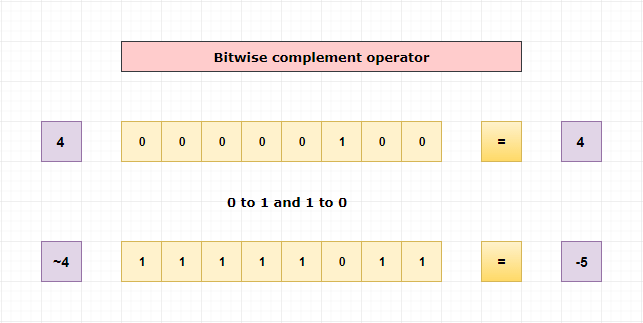Bitwise one's complement operator (~)
Bitwise one's compliment operator will invert the binary bits.
If a bit is 1, it will change it to 0.
If the bit is 0, it will change it to 1.
Example
Let’s take a number 4.
Then ~4 will be,
4 = (00000100) 2
~4 = (11111011) 2.It will convert all 1 to 0 and 0 to 1.
Pictorial Explanation

If we print the value of ~4 using printf, it will print -5. How?
Let's take a look on how -5 will be stored in computer?
As we discussed earlier negative numbers are represented using 2’s complement form.
To know how to calculate 2’s complement of a number, kindly refer the link.How integers are stored in memory
So, -5 will be stored like below,
5 = (00000101) 2
1’s complement of 5 = (11111010) 2
Add 1 to get the 2’s complement,
-5 = (11111011) 2
Result of ~4 is equal to the representation of -5 in binary, hence ~4 is -5.
Example 2
Let’s take number 2,
2 = (00000010) 2
1’s complement of 2 = (11111101) 2
Add 1 to get the 2’s complement,
~2 = (11111101) 2
Result of ~2 is equal to the representation of -3 in binary, hence ~2 is -3.
Program using bitwise ones complement operator
Example
#Bitwise ones complement operator in python var = 3 print("value = ", ~var) # which is equal to -4